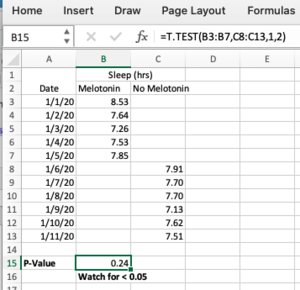Difference between revisions of "Is it chance? Use a T-Test to identify how likely an intervention worked"
| Line 30: | Line 30: | ||
The P Value in this example, `0.24`, is above `0.05` and therefore we will assume that any difference in sleep between the nights is due to pure chance. | The P Value in this example, `0.24`, is above `0.05` and therefore we will assume that any difference in sleep between the nights is due to pure chance. | ||
| + | |||
| + | {{Topic Queries}} | ||
Revision as of 22:30, 24 February 2022
Problem
You tried an intervention and want to see if it worked. How likely is it that the results were chance?
Solution
One of the simplest tests is a T-Test, sometimes called a “Student T Test”.
Statisticians use the concept of P Value to discuss the how often a result might appear to be significant even when it’s not. While this crude measure doesn’t describe all the ways something might happen due to chance, generally the lower the P Value, the better. Professional scientists, especially those who understand statistics, will get touchy if you claim a result based purely on P Values, but for Personal Science purposes, it’s a good start. There is no “correct” cutoff value that can determine the likelihood that something is due to chance alone, but traditionally people assume that anything under 0.05 deserves a closer look.
Here’s an example for how to do this in Excel.
Suppose you’d like to know if taking a melotonin supplement will help you sleep longer. You’ve measured your daily sleep, taking the supplements on some days (the “intervention”) and not on others (“control”).
A simple spreadsheet might look like this:
Track your sleep under two columns: one for nights when you took the supplement, and the other for nights you didn’t.
The built-in Excel statistical function T.TEST will calculate the P-Value when you give it two ranges, the “intervention” (nights we took melotonin) and the “control” (nights without).
See the screenshot for the exact formula in this case:
=T.TEST(array1,array2,tails,type)
Enter a `1` for `tails` (because we’re only interested in one measurement, sleep) and a `2` for type (because in this case our samples are not of the same length).
The P Value in this example, `0.24`, is above `0.05` and therefore we will assume that any difference in sleep between the nights is due to pure chance.
Linked content on this wiki
(The content in the table below is automatically created. See Template:Topic Queries for details. If newly linked pages do not appear here, click on "More" and "Refresh".)
| Tools related to this topic |
|---|
| Excel |
| Projects related to this topic |
|---|
| Self researchers related to this topic |
|---|
| We talked about this topic in the following meetings |
|---|
